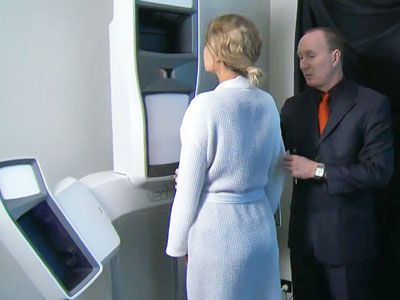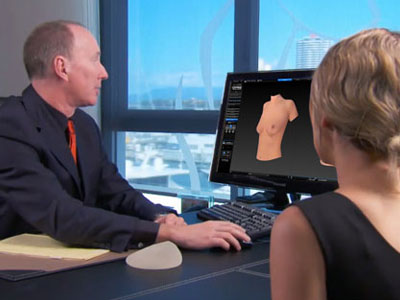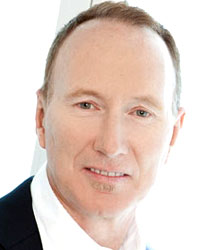Plastic Surgery on Australia's Gold Coast

Pausing to adjust her sunglasses, a fashionably dressed woman emerged from the Hatteras 70 motor yacht docked at Marina Mirage in Australia's Gold Coast. Walking past the outdoor cafe and through the glass doorway to the reception area, she settled into a comfortable chair by the window. From there she could gaze out over the water while awaiting her appointment at Queensland's acclaimed beauty destination, the Esteem Medi Spa.
Here Dr. Terrence Scamp, one of Australia's leading plastic and reconstructive surgeons, has realized his vision of "putting all the beautifying processes under one roof", and visitors will find everything from manicures to laser treatments to breast augmentation. And while he takes pride in the variety of these services, the core of his practice has always been aesthetic plastic surgery. It's not surprising, then, that he was the first plastic surgeon in the region to adopt the VECTRA 3D imaging system for his practice.
"I had long wanted a 3D system for rhinoplasty simulation" Dr. Scamp explains, "but while this procedure is a great love of mine, it makes up a much smaller part of my practice than breast augmentation. When I found that the VECTRA XT could do both, it made obvious sense to purchase one. It was exciting to be the first in this area, and we were quick to let its capabilities be known. It invariably impresses and intrigues those who see it for the first time. Now it's become much more widespread, and in fact, patients have come to expect it."
 Dr. Scamp was the first in this area to have a VECTRA XT
Dr. Scamp was the first in this area to have a VECTRA XT
Mutual education
Such expectations are largely a result of the reputation that Dr. Scamp built throughout the Gold Coast region. By enabling surgical prospects to preview the virtual outcomes of their aesthetic procedures, he has eliminated the "fear of the unknown" which prevents many patients from moving forward. And because both patient and surgeon have agreed upon the aesthetic objective, he has found that these patients are in the end more satisfied with the results.
VECTRA 3D simulations also help Dr. Scamp educate himself as to how he might approach a challenging surgical objective. "It can be hard for the lay person to understand, and in fact it is often not immediately obvious to the surgeon himself, that building up the upper portion of the nose can help make the tip or the bridge line look smaller. This tinkering with the image on the VECTRA system can be educational for all concerned."
This ability to quickly simulate different outcomes has had a profound effect on his consultations. In breast augmentation particularly, it has dramatically reduced the need to tediously demonstrate multiple previous results. "Before I had the VECTRA, it would be a struggle to find photographs of past patients with similar breast size and shape, and the appropriate implant selection. Now, multiple sizes can be tried in moments, and this facilitates the efficient progress of the consultation."
 VECTRA 3D has had a profound effect on Dr. Scamp's consultations
VECTRA 3D has had a profound effect on Dr. Scamp's consultations
Mastopexy and more
VECTRA simulations also allow Dr. Scamp to demonstrate the adverse effect of an inappropriate implant, or the unfavorable result of an augmentation alone when a lift is also needed. "In these cases, the new mastopexy simulation module in VECTRA has proven to be quite useful. It lets me show mastopexy candidates a comparative result, with or without a lift. This allows them to weigh the benefits of a lift in improving their overall result versus the downside of the extra scarring."
This type of patient communication also helps Dr. Scamp identify prospective patients who may not be good candidates for a procedure. "If the surgeon creates an image he thinks is appropriate for the patient's morphology and the patient is after something totally different, this may warn of a patient's unrealistic expectations and their unsuitability for surgery" he explains.
Patients with asymmetric breasts present a particular challenge for both augmentation and reduction procedures. And here the measurement tools in VECTRA software provide a solution. In the reduction of asymmetric breasts, these measurements help Dr. Scamp estimate the appropriate amount of resection on each side. For augmentation, the measurements are used to "tweak" the simulations and achieve a more symmetrical appearance, which also guides implant selection in the surgical plan.
A calming influence
Asked where VECTRA has made the most significant contribution to his practice, Dr. Scamp does not hesitate. "What I think benefits patients the most is the striking decrease in anxiety prior to surgery. Even for those who have made the decision to proceed, there is often a little bit of stage fright. Last minute phone calls to discuss the implant size again, or some technical aspect to do with the final shaping of the nose."
The VECTRA system has clearly helped ease this fear and uncertainty. "In the time that I have been using VECTRA 3D, I have noticed an increased calm in the people undergoing surgery. I believe this is because of the fact that they are more certain of the outcome before going off to sleep. It gives them a greater sense of security in the destination of their journey." Dr. Scamp then heads off to his next appointment, while through the window a motor yacht can be seen making its way slowly out toward the blue water of the South Pacific.
 Dr. Terrence Scamp
Dr. Terrence Scamp
Dr. Terrence Scamp graduated from the University of Queensland in 1980 and interned at Princess Alexandra Hospital in Brisbane. He then moved into surgical training and obtained experience in Vascular, Orthopedic, Neurosurgery and General Surgery. He trained in Plastic and Reconstructive Surgery at the Royal Brisbane Hospital, followed by a further year at Princess Alexandra Hospital. Dr. Scamp obtained his specialist qualification as a Fellow of the Royal Australasian College of Surgeons (FRACS) in the division of Plastic and Reconstructive Surgery in 1990. Dr. Scamp completed his training with over 3 years abroad, in leading centers in the United Kingdom, Europe and the USA. Following this, he returned to surgical practice on the Gold Coast.
